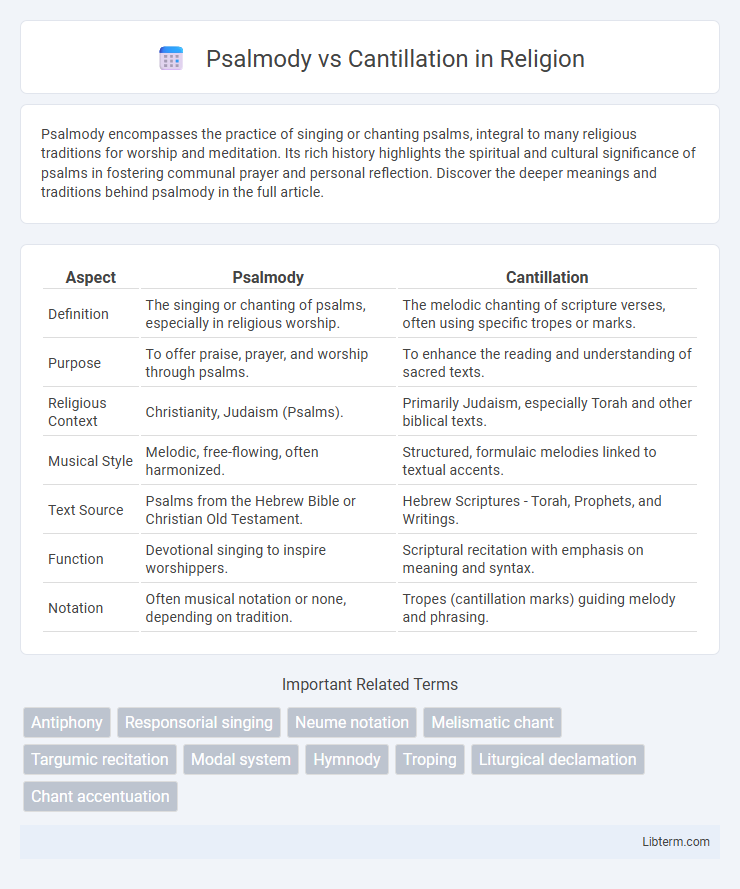Psalmody encompasses the practice of singing or chanting psalms, integral to many religious traditions for worship and meditation. Its rich history highlights the spiritual and cultural significance of psalms in fostering communal prayer and personal reflection. Discover the deeper meanings and traditions behind psalmody in the full article.
Table of Comparison
| Aspect | Psalmody | Cantillation |
|---|---|---|
| Definition | The singing or chanting of psalms, especially in religious worship. | The melodic chanting of scripture verses, often using specific tropes or marks. |
| Purpose | To offer praise, prayer, and worship through psalms. | To enhance the reading and understanding of sacred texts. |
| Religious Context | Christianity, Judaism (Psalms). | Primarily Judaism, especially Torah and other biblical texts. |
| Musical Style | Melodic, free-flowing, often harmonized. | Structured, formulaic melodies linked to textual accents. |
| Text Source | Psalms from the Hebrew Bible or Christian Old Testament. | Hebrew Scriptures - Torah, Prophets, and Writings. |
| Function | Devotional singing to inspire worshippers. | Scriptural recitation with emphasis on meaning and syntax. |
| Notation | Often musical notation or none, depending on tradition. | Tropes (cantillation marks) guiding melody and phrasing. |
Introduction to Psalmody and Cantillation
Psalmody involves the melodic chanting of psalms and sacred texts, emphasizing rhythmic and tonal patterns to enhance liturgical worship. Cantillation refers to the precise vocalization and musical notation used to chant scripture, often incorporating specific cantillation marks that guide melodic intonation and phrasing. Both practices play a crucial role in preserving and conveying religious texts through music in various traditions.
Historical Origins of Psalmody and Cantillation
Psalmody traces back to ancient Jewish temple worship, where Psalms were sung as integral liturgical chants to accompany sacrifices and prayers, serving both communal and ritual functions. Cantillation originated from the Masoretic tradition around the early medieval period, developing a system of musical notes and accents to guide the precise chanting and interpretation of Hebrew Scriptures. These distinct historical origins highlight Psalmody's focus on devotional singing while Cantillation evolved as a scholarly method to preserve textual accuracy and enhance scriptural recitation.
Core Differences in Musical Structure
Psalmody features a melodic chant structure characterized by simple, repetitive tones that emphasize lyrical declamation and spiritual reflection. Cantillation involves complex, ornamented musical phrases with specific melodic motifs that guide the chanting of scriptural texts, often incorporating precise rhythmic patterns and modal shifts. The core difference lies in psalmody's emphasis on meditative repetition versus cantillation's intricate melodic articulation aligned with textual syntax.
Liturgical Contexts and Usage
Psalmody refers to the singing or chanting of psalms, primarily used in Christian and Jewish liturgical settings to enhance prayer and worship experiences. Cantillation involves the ritual chanting of scriptural texts, especially the Hebrew Bible, following specific melodic patterns to aid in textual interpretation and memorization within synagogue services. Both practices serve distinct liturgical functions, with psalmody emphasizing devotional singing and cantillation focusing on precise scriptural recitation during worship rituals.
Notational Systems and Interpretation
Psalmody employs neumatic notation systems that provide melodic contours for chanting Psalms in liturgical contexts, emphasizing fluid vocal expressions. Cantillation uses specific trope marks within Hebrew script to indicate precise cantillation melodies and syntactic phrasing essential for Torah and biblical text chanting. Interpretation of psalmody relies on melodic tradition and context, while cantillation integrates grammatical cues to guide accurate textual emphasis and punctuation during recitation.
Vocal Techniques and Performance Styles
Psalmody emphasizes melismatic vocal techniques characterized by elongated, ornamented phrases within a meditative and solemn performance style rooted in liturgical traditions. Cantillation employs precise, formulaic melodic motifs with short, repetitive phrases designed to aid scriptural chanting and enhance textual comprehension through rhythmic and tonal patterns. The performance of psalmody often involves soloists or choirs delivering expressive, fluid interpretations, while cantillation typically utilizes trained cantors following established chant notations to maintain clarity and ritual consistency.
Role in Worship and Spiritual Practice
Psalmody involves the musical chanting of Psalms, often serving as a central element in Christian and Jewish worship to enhance communal prayer and reflection. Cantillation refers to the specific melodic chanting of scriptural texts, particularly in Hebrew, used to preserve the precise pronunciation and meaning during Torah readings. Both practices play crucial roles in spiritual disciplines by fostering deeper engagement with sacred texts and elevating the worship experience through structured vocal expression.
Regional Variations and Traditions
Psalmody and cantillation exhibit significant regional variations shaped by diverse cultural and liturgical traditions across Jewish communities. In Sephardic and Mizrahi traditions, cantillation melodies often feature intricate ornamentation and modal scales influenced by Arabic music, while Ashkenazi chant tends to emphasize structured, repetitive motifs with European folk influences. Distinctive regional psalmody styles reflect local linguistic nuances and historical interactions, underscoring the complex interplay between geography and religious musical expression.
Modern Adaptations and Revivals
Modern adaptations of psalmody emphasize contemporary musical styles and accessible language to engage broader audiences, often incorporating diverse genres like gospel, jazz, and folk. Cantillation has seen a revival through digital platforms and detailed instructional materials that preserve traditional chanting methods while encouraging interactive learning. Both practices benefit from technological advances that blend historical authenticity with innovative presentation, fostering renewed interest across religious and cultural communities.
Comparative Significance in Religious Communities
Psalmody and cantillation serve distinct, yet complementary roles in religious communities, enhancing worship through vocal expression and sacred text interpretation. Psalmody, the melodic chanting of Psalms, fosters congregational participation and spiritual reflection, often emphasizing communal unity in Jewish and Christian liturgies. Cantillation, the ritual chanting of scriptural texts with specific motifs, preserves linguistic accuracy and theological nuances, crucial for maintaining tradition in synagogues and some Christian rites.
Psalmody Infographic

 libterm.com
libterm.com